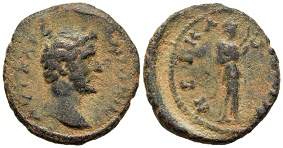Fine Coins Showcase
Antiquities Showcase
Show Empty Categories
Shop Search
Shopping Cart
My FORVM
Contact Us
About Forum
Shopping at Forum
Our Guarantee
Payment Options
Shipping Options & Fees
Privacy & Security
Forum Staff
Selling Your Coins
Identifying Your Coin
FAQs
zoom.asp
Home ▸ Catalog ▸ |Greek Coins| ▸ |Geographic - All Periods| ▸ |Anatolia| ▸ |Bithynia||View Options:   | | | | | | The kingdom of Bithynia held a considerable place among the minor monarchies of Anatolia. The coins of the Bithynian kings depict their regal portraits in a highly accomplished Hellenistic style. Nicomedes IV, the last king of Bithynia, was defeated by Mithridates VI of Pontus, and, after being restored to his throne by the Roman Senate, bequeathed his kingdom by will to the Roman Republic in 74 B.C. Under Rome, the boundaries of Bithynia frequently varied and it was sometimes united with Pontus. For securing communications with the eastern provinces, the monumental Bridge across the river Sangarius was constructed around 562 AD. Troops frequently wintered at Nicomedia. The most important cities were Nicomedia, founded by Nicomedes, and Nicaea. The two had a long rivalry with one another over which city held the rank of capital. At a much earlier period the Greeks had established on the coast the colonies of Cius (modern Gemlik); Chalcedon (modern Kadiköy), at the entrance of the Bosporus, nearly opposite Byzantium (modern Istanbul) and Heraclea Pontica (modern Karadeniz Eregli), on the Euxine, about 190 km east of the Bosporus. |


The referenced coin, RPC Online VI T3432 = Rec Gén 334, is the only known specimen of this type and RPC notes, "Tooled, likely not belonging to Nicomedia." The present coin confirms attribution to Nicomedia. Furthermore, this type for Julia Mamaea nicely complements the Severus Alexander issue with the same reverse (RPC Online VI T3435). RP113006. Bronze assarion, RPC Online VI T3432 corr. (legends), Rec Gén 334 corr. (same), F, green patina, weight 3.540 g, maximum diameter 18.4 mm, die axis 210o, Nicomedia (Izmit, Turkey) mint, group 1b, 222 – 235 A.D.; obverse IOVΛIA MΑMAIA CEBAC, draped bust right; reverse NIKOMHΔEΩN ΔIC NEΩKOPΩN, veiled and draped bust of Demeter right, wearing stephane, stalks of grain before her; 2nd known and the best of the type known to FORVM; extremely rare!; $180.00 (€169.20)
Antoninus Pius, August 138 - 7 March 161 A.D., Nicaea, Bithynia


According to myth, Hermes and Dionysos were sons of Zeus, but Hermes' mother was the princess Semele and Dionysos' mother was the minor goddess Maia. To protect the infant Dionysos from his wife Hera, Zeus entrusted him to Hermes, who together with a band of nymphs, hid the child near Mt. Nysa in Anatolia.RP111796. Bronze hemiassarion, RPC Online IV 5875 (3 spec.); Rec Gen 79; SNG Cop 480 corr. (obv. leg., M. Aurelius), aVF, dark and earthen patina, weight 4.044 g, maximum diameter 19.2 mm, die axis 180o, Nicaea (Iznik, Turkey) mint, obverse AVT KAICAP ANTΩNINOC, laureate head right; reverse NIKAIEΩN, Infant Dionysos seated right in cradle, extending both arms, thyrsus in cradle behind (not visible); Coin Archives records only one specimen of the type at auction in the last two decades; very rare; $135.00 (€126.90)
Antoninus Pius, August 138 - 7 March 161 A.D., Nicaea, Bithynia


Nicaea remained an important town throughout the imperial period. Although only 70 km (43 miles) from Constantinople, Nicaea did not lose its importance when Constantinople became the capital of the Eastern Empire. The city suffered from earthquakes in 358, 362 and 368; after the last of which, it was restored by Valens. During the Middle Ages, it was a long time bulwark of the Byzantine emperors against the Turks.RP113281. Bronze AE 17, apparently unpublished variant; RIC IV.1 T5889 var. (obv. leg.); SNG Cop 474 (same); Rec Gén 95.2, pl. LXIX.2 (rev. only) (same), VF, rev. off centered, porosity, light marks, clay-rich sediments, weight 3.752 g, maximum diameter 19.5 mm, Nicaea (Iznik, Turkey) mint, 138 - 161 A.D.; obverse AVT KAIC ANTΩNINO-C, Bare head right; reverse NEIKA-IEΩN, Hygieia standing right, feeding serpent in her arms from patera in right hand; extremely rare; $110.00 (€103.40)
CLICK HERE TO SEE MORE FROM THIS CATEGORY - FORVM's PRIOR SALES



REFERENCES
Page created in 1.141 seconds.








